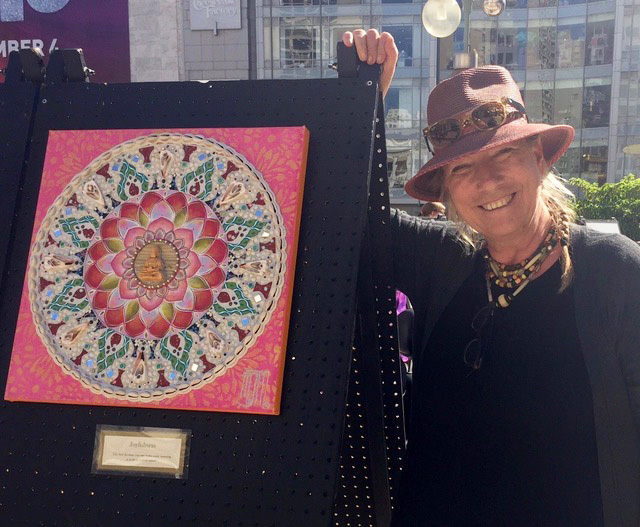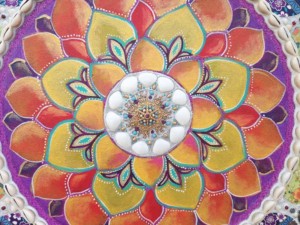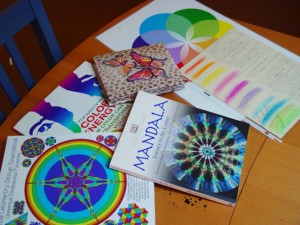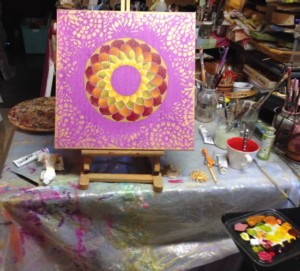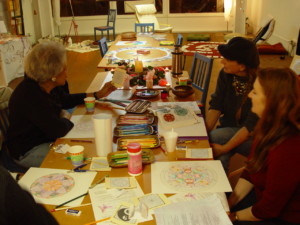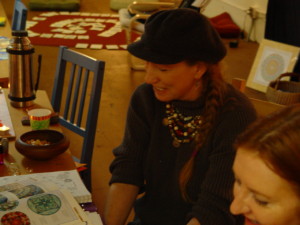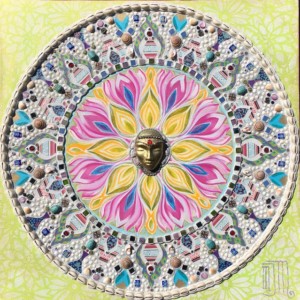Feather River Art Camp to Offer New Workshop on the Art of the Mandala
by Ed Mickens
“Each of us is the container of our own story, and the process of drawing our own circle and examining our own dialogue can be very emotional.”
“Creating a mandala brings us back to who we are,” says Bay Area artist Marion Maenner. “For me, it’s an opportunity to reflect on what’s going on in the outer world, from relationships to politics, then to retreat while I create, to immerse myself in the colors, the materials, the ideas I have at hand. I get new perspectives. I can make sense of life. I find my own truth.”
Those are goals Marion hopes to share to share with students when she joins the faculty at the next Feather River Art Camp, June 18-25, 2017. “I’m interested in the relationship between creativity and the mind.
There’s the thought process, the technical issues of how to put together a piece of art—but that inner dialogue quiets the mind. There’s a meditative aspect, a healing, a chance to step away from the self-doubt, the self-nagging, that monkey mind. The creative process is part of our soul, our inner child let out to play.”
Marion offers the technical process she has honed over the years, as she gradually applies paint to canvas: thick swaths of acrylic paint, thick as paste. (“Then, of course, you have to wait for it to dry,” she winks. “Fortunately, when it’s warm and dry, it goes faster.”)
Those brilliant veins become host for an inlay of shells, paper forms, found objects, inscribed words—as they merge slowly and spiral into the ancient symbol of the circle of life. Every line becomes, literally, a story line from life. Step back and look at it.
Simply put, “the mandala is the pattern of every form of organic life,” explains the artist. “Think of the egg cell: a dot surrounded by a larger circle. That central dot is life, the cosmic spark, that grows to fill and expand what surrounds it.
The dot spins new patterns, it grows room after room of life experiences. All life uses that pattern. Even the Big Bang is a mandala.”
Marion does not take her scientific analogies lightly: she trained as a naturopathic doctor in her native Germany. “I think I was always an artist,” she recalls, but family and society squelched those ideas, and pushed her “into something practical, like medicine.
I used to fill my notebooks and all the little boxes with elaborate, fanciful drawings. I realize now these were meditations, but the teachers never liked it.”
Fortunately, she was able to balance her studies with travel, especially through Asia, where she found herself drawn to longer and more extensive stays. “I studied shiatsu in Japan, and through Hinduism and Buddhism, I was introduced to the ancient forms, like the mandala and the Tree of Life.”
She returned to Germany with a new interest in the connection between the creative arts and the healing arts. It was also a time when other scholars were publishing studies along similar lines. “Suddenly, it didn’t seem so crazy anymore to talk about a magical circle that’s meditative and healing.”
“So much of our interior dialogue is about self-doubt, or criticism or guilt, and that has an effect on the physical body. Stepping back to look at that inner conversation, like a movie, allows us to acknowledge it without accepting what our monkey tells us is true. Rejecting negative emotions is healing. That role creativity plays in this—whether you find it in cooking, or yoga or art—is very much part of the relationship between the left-brain and the right-brain.”
Her explorations into these ideas, however, were soon superseded by the (happy) demands of marriage and motherhood. Some years later, another disruptive life event brought them back: her husband’s job transfer to the United States, where her medical degree and certificates were not accepted.
“I found myself a suburban housewife, frustrated because the future didn’t look like I expected.” She did, eventually, discover local artists’ groups, where she was encouraged to go back to her creative inclinations.
Today, her work is in high demand and she exhibits widely, often with Red Umbrellas, the San Francisco-based collaboration of artists. She sits on the group’s board, and manages much of its day-to-day business. (“Keeps my left-brain satisfied.”)
Her workshops at Feather River are a new venture. “I never want to work in a typical community center or classroom. I don’t like the energy,” Marion explains. “I usually try to find a host, a home, where the energy is warm and supportive. That’s the atmosphere I hope to duplicate at camp—and, of course, working amid nature is just wonderful.”
She emphasizes how personal, and often very powerful, the experience of making a mandala can be. “Each of us is the container of our own story, and the process of drawing our own circle and examining our own dialogue can be very emotional. I am amazed every time.”
The five-day workshop will have structured mornings (9:30am-12:30pm) where Marion will offer a variety of art materials as well as material for inspiration: affirmation cards to provoke inner dialogue, color cards for students to try on the energies and messages across the spectrum. “I don’t think of myself as a teacher, but as a catalyst for each to find their own truth.”
Afternoons are unstructured, for students to work at their own pace, with or without Marion’s guidance. Ultimately, “the workshop itself becomes its own circle, with its own life, made up of the lives and experiences of the participants combined. It goes with the flow and becomes its own dance, joyous and incredible.”
Marion Maenner has a clear sense of goals, once the workshop dance completes: “What do the participants take away with them? Inner peace. Their own truth. And a great piece of art.”

